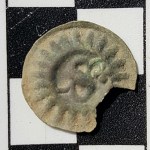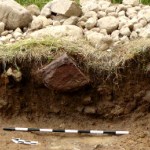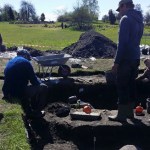excavation
Our second week at Skällvik Castle proved a continued small-finds bonanza, and we also documented some pretty interesting stratigraphy.
More of everything in Building IV. In addition to more coins of Magnus Eriksson, dice and stoneware drinking vessels, we also found a lot of points for crossbow bolts. It's starting to look like the castle guards' day room! As for why we found crossbow bolts only inside one building and none outdoors in the bailey, I figure that they had been amassed there for re-fletching. The dark indoors find context and the undamaged sharp points show that the bolts did…
The famous royal castle of Stegeborg sits on its island like a cork in the bottleneck of the Slätbaken inlet (see map here). This waterway leads straight to Söderköping, a major Medieval town, and to the mouth of River Storån which would allow an invader to penetrate far into Östergötland Province's plains belt. The area's first big piece of public construction was 9th century fortifications intended to guard this entrypoint, in the shape of the Götavirke earthen rampart some ways inland and a wooden barrage at Stegeborg. This barrage was kept up for centuries, and indeed, the castle's name…
We spent Thursday afternoon backfilling. As I write this, only trench G remains open, and the guys there expect to finish soon. Here's some highlights of what we've learned during our second week at Birgittas udde.
Trench A in the outer moat demonstrated that the moat had a wide flat bottom, was not very deep and contains no lake sediments. Probably always a dry moat, providing material for the bank behind it. No Medieval finds.
Trench C: section through the deep inner moat.
Trench C in the inner moat demonstrated that this moat too had a wide flat bottom, but it was deeper and is full of…
This year's first week of fieldwork at Stensö Castle went exceptionally well, even though I drove a camper van belonging to a team member into a ditch. We're a team of thirteen, four of whom took part in last year's fieldwork at the site. All except me and co-director Ethan Aines are Umeå archaeology students. We're excavating the ruin of a castle that flourished in the 13th and 14th centuries. This year we have a very nice base at Smedstad, let to us by the genial B&B host Hans-Ola. But we cook our own meals, each day having its designated cooks and dishwashers, and in the evenings we…
Last year I headed four weeks of excavations at two previously unexplored castle ruin sites near the Swedish city of Norrköping: Landsjö in Kimstad and Stensö in Östra Husby. Finds and written sources suggest that both were built and inhabited in the 13th and 14th centuries. All known owners were members or close relatives of the powerful Ama family. Now Ethan Aines and I have finished the archive reports, available here on ScienceBlogs [Landsjö and Stensö] and on Archive.org. Rudolf Gustavsson's osteological reports (in Swedish) are included. Comments and questions are most welcome…
When I tell people I'm an archaeologist, they often ask ”So have you dug at Birka?”. As of yesterday I can finally proudly reply ”yeah, a bit”.
”Birka” is a Latinate attempt to write Biærkey, ”Birch Island”. It's an island in Lake Mälaren, two hours by slow boat from Stockholm. For a bit more than 200 years starting in the mid-8th century, it hosted the first town on Swedish soil, established there as a regulated international trading post under the protective (and probably tax-grabbing) hand of the Kings of the Swedes. This immortally classic Viking Period site has huge cemeteries, a huge…
Having read yesterday's entry about what I need to get hold of before I can dig a site, Apel Mjausson asked me on Facebook, "How do you decide where to dig? Sweden is lousy with unexplored sites. Are you following a specific story, looking at place names, take nominations...?"
Disregarding sites I've been paid to dig and sites I've only metal-detected,* my motivations have been as follows. To begin with, I only ever dig sites that I judge likely to produce something publishable and exciting. (And sometimes I lose on that gamble).
At Barshalder in 1997 I dug two graves because at my advisor's…
I've headed my own research excavations since 1996. Now I'm preparing for four weeks of fieldwork during the upcoming season. I operate as an independent scholar in this context, and none of my excavations have been prompted by land development. Here's what I need to get hold of before I can break the turf or metal-detect the plough soil on an archaeological site in Sweden.
Contacts/notoriety. I couldn't get much of what's listed below without contacts/notoriety in the business.
Funding. Most of my research money comes from small private foundations in annual instalments of about $3,600 (€3,…
How is it that a construction firm that specializes in underground utility work and excavation can be so dense when it comes to knowing the fundamentals of protecting workers from cave-ins? Or is it that they know the fundamentals but just choose not to apply them.
The Houston-area excavation firm SER Construction Partners was cited last month by the Occupational Safety and Health Administration (OSHA) for willfully failing to comply with standards for safe excavation practices. The OSHA news release announcing the sanction appropriately, noting:
"A cave-in can turn into a grave…
News!
Toba caldera in Indonesia.
We're all still talking about the Chilean earthquake and the coverage of the event. If you happen to live in the Columbus area, you might have heard me on WTVN talking about the earthquake as well.
The Toba (Indonesia) eruption 74,000 years ago has been used by some researchers to be the cause of a "genetic bottleneck" for humans - however, that is still much debated. Currently, excavations are under away near Toba to look for evidence of human habitation that was buried by the eruption. The evidence of stone tools that appear to be made by the same human…
tags: ants, hymenoptera, excavating ant city, nature, science, streaming video
This fascinating video details how a scientist learns what an ant colony looks like in the wild -- it's astonishing how big these things can get [3:16]




